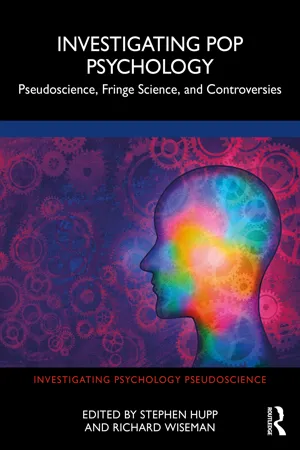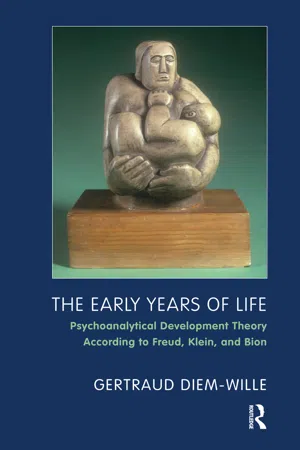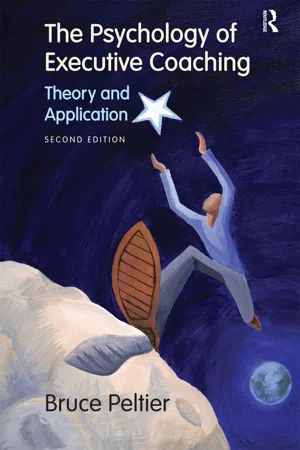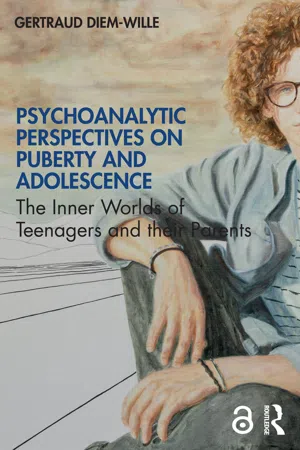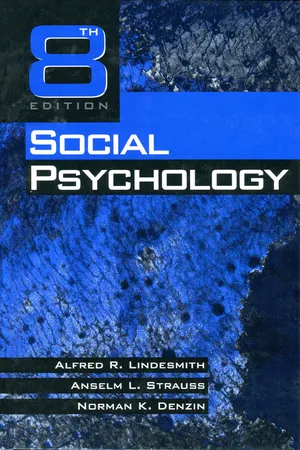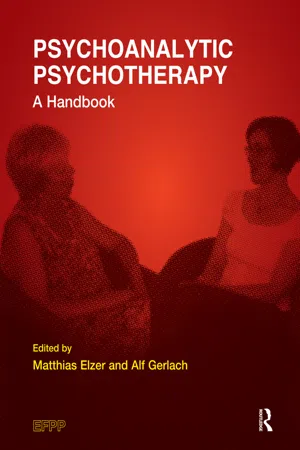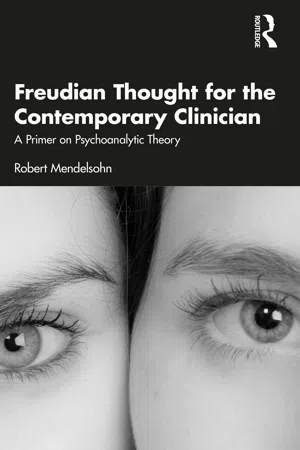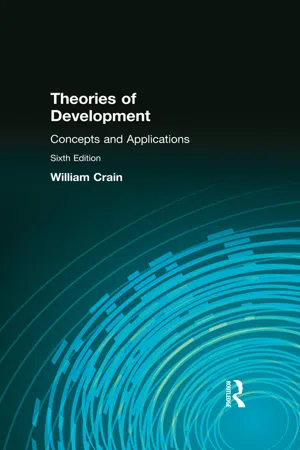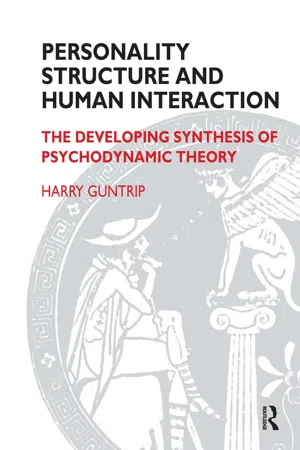Psychology
Psychosexual Stages Of Development
Psychosexual stages of development, proposed by Sigmund Freud, describe the progression of sexual development from infancy to adulthood. According to Freud, individuals pass through five stages—oral, anal, phallic, latency, and genital—each characterized by a focus on different erogenous zones. Successful navigation of these stages is believed to contribute to healthy psychological development.
Written by Perlego with AI-assistance
Related key terms
11 Key excerpts on "Psychosexual Stages Of Development"
- eBook - ePub
Investigating Pop Psychology
Pseudoscience, Fringe Science, and Controversies
- Stephen Hupp, Richard Wiseman, Stephen Hupp, Richard Wiseman(Authors)
- 2022(Publication Date)
- Routledge(Publisher)
Table 9.1 for an overview.Table 9.1Sigmund Freud's five psychosexual stagesStage Age Range Behavior Exhibited Oral Birth–1 year The mouth or oral zone was associated with infants’ natural instinct to nurse. Anal 1–3 years Toilet training begins, and children start discovering pleasure in the voluntary control of defecation and urination. Phallic 3–5 years Children discover the significance of their genitals and the pleasure experienced in that erogenous zone. Latency 5 years–puberty Sexual drives are repressed or forgotten until adulthood. Genital Adolescence Teenagers balance basic sexual urges with the need to conform to societal norms. Freud indicated that children moved sequentially through these psychosexual stages, claiming virtually all areas of one's personality were influenced by successes or failures navigating developmental challenges related to each stage (Kalat, 2013 ). According to Freud, all normal and abnormal behavior was a result of early experiences forming the foundation of the personality (Miller, 1983 ). The corresponding erogenous areas associated with the oral, anal, and phallic stages generated sexual tensions that required stimulation or relief. Unhealthy levels of stimulation (i.e., too little or too much) at any one of these stages caused the child to be fixated, or stuck, resulting in the development of personality types associated with the specific stage (Greenwood, 2015 - eBook - ePub
Graphic Guides
A Graphic Guide
- Nigel Benson(Author)
- 2014(Publication Date)
- Icon Books(Publisher)
4. The Stages of Psychosexual Development Freud described 5 stages we all pass through: Oral (0-2 yrs)Anal (2-3 yrs)Phallic (3-6 yrs)Latent (6-11 yrs)Genital (11 + yrs) The first three stages are particularly important for personality development.The Oral Stage (0-2 yrs)
The mouth is the prime source of pleasure, for survival: the baby instinctively sucks. Through oral satisfaction, the baby develops trust and an optimistic personality.If there is lack of oral stimulation – if weaned too early – then the personality may become pessimistic, distrusting, cynical or aggressive.Being “stuck” at this stage is Oral Fixation.The Anal Stage (2-3 yrs)
The focus of pleasure shifts to the anus, helping the child become aware of its bowels and how to control them, aiding “potty training” – going to the toilet in the right place and time. Parents should encourage regularity and hygiene. By deciding itself, the child takes an important step of independence, developing confidence and a sense of when to “give things up”. However, over-strictness about forcing the child to “go”, or about timing or cleanliness, can cause personality problems – depending on how it reacts…Examples of Anal FixationForcing the child to “go” may cause reluctance about giving away ANYTHING. The person may become a hoarder or a miser – classic Anal Retention!Similarly, over-concern about “going regularly” may cause either obsessive time-keeping – or the type who’s always late. Over-emphasis on cleanliness may cause an obsessive personality, always concerned about being clean and tidy. Or, rebelling, someone who’s always untidy.The Phallic Stage (3-6 yrs)
Children become aware of their genitals (“playing with themselves”) and sexual differences. Consequently, development is different for boys and girls. - eBook - ePub
The Early Years of Life
Psychoanalytical Development Theory According to Freud, Klein, and Bion
- Gertraud Diem-Wille(Author)
- 2018(Publication Date)
- Routledge(Publisher)
Chapter Five The psychosexual development of a childWhen we speak of the psychosexual development of a child instead of “sexuality”, this implies a broader understanding of sexuality also including seemingly asexual forms of behaviour. The development of infantile sexuality, as described by Freud in his “Three Essays on the Theory of Sexuality” (1905a), is a significant addition to the understanding of intra-psychical connections. Freud situates sexuality in the unconscious, which he sees as the liminal area between soma and psyche. Since it is a central notion of psychoanalytic understanding we will take a closer look at sexuality.5.1 A broader understanding of sexuality
Freud (1917: 320) uses the notion of sexuality differently than it is commonly employed in everyday language. He not only uses it to refer to the differences between the sexes, the sexual act, and procreation but to describe every form of pleasure and satisfaction which can be derived from its objects—that is, also eating, playing, and much more. Most of our thoughts and acts are based precisely on these acts—and they are also activated in sleep. Sexuality is meant in a much broader sense, and Freud (1917: 320) uses the term “libido” to refer to it. This broader understanding of sexuality is linked to the development of personality (Nietzschke, 1988). Freud himself suggested using the term “psychosexuality” in psychoanalytic theory, since the psychic factor is decisive in connection with the relationship to parents and siblings (Freud, 1910: 119). Here the issue is the individual’s capacity to love, linked with an intense, emotional, and affective experience during the sexual act and not an erection or ability to achieve an orgasm. The personality is the product of the development of infantile sexuality into the mature psychosexuality of the adult. Psychosexuality thus cannot be identified with sexual behaviour measured by experimental means (Kinsey, 1948, 1953). It can be influenced by psychic factors such as anxiety, hate, and guilt feelings and be intensified by tenderness and love. Thus a technically successful sexual intercourse without tender feelings can leave behind a shallow, even repulsive feeling, in lieu of happiness and fulfilment. Freud was able to attain an understanding of the unconscious roots of psychosexuality by studying abnormal behaviour, perversion, and sexual aberrations. Freud (1905: 170) assumed that “normal” manifestations of sexual drives could essentially not be separated from “abnormal” ones: - eBook - ePub
The Psychology of Executive Coaching
Theory and Application
- Bruce Peltier(Author)
- 2011(Publication Date)
- Routledge(Publisher)
It is always better to have a job that fits. In fact, the leadership literature described in Chapter 15 emphatically emphasizes leader–task fit. Freud’s Psychosexual Stages Developmental psychology in the West begins with the work of Sigmund Freud. His psychodynamic view of psychotherapy is described in Chapter 3, and his stages of childhood development are described next. The description is brief and offered mostly as historical backdrop. Much of Freud’s work on psychosocial stages has been discarded by modern psychology, and most of it focused on childhood and adolescence (rather than adult development). Nonetheless, it is uncommon to go through a week in the workplace without hearing the term anal used to describe a compulsive or obsessively organized colleague or oral to describe someone who smokes or drinks too much. Others are described as having a big ego, a term that originated with Freud’s work. Freud’s psychosexual stages are really stages of personality development and his overall theory focused on infantile sexual urges that are aggressive, unacceptable, and repressed. He organized stages around the erogenous zone he thought was primary at that stage of personality organization. What follows is a simplified description of the stages and their characteristics. One can get stuck at any of these stages, and such a “fixation” is problematic thereafter. Remember that these views are no longer widely held in psychology. Oral (birth to 18 months or so)—Gratification in this stage derives from the mouth. A child’s earliest experiences with feeding are central to development. If feeding and oral gratification do not go well, a child becomes orally fixated, resulting in neediness, dependence, helplessness, or problems in overt oral behaviors such as overeating, smoking, or drinking. Anal (age 1 to about age 3)—In this stage, gratification and pleasure involve the anus and elimination. Toilet training is the organizing task to be mastered - eBook - ePub
Psychoanalytic Perspectives on Puberty and Adolescence
The Inner Worlds of Teenagers and their Parents
- Gertraud Diem-Wille(Author)
- 2020(Publication Date)
- Routledge(Publisher)
Another important phenomenon is the “ambivalence of feelings” Freud first discussed in 1912 in his “The Dynamics of Transference”: the same person becomes the object of both love and hate; this person is meant both to become jealous and trusting or emotionally accessible. Such ambivalent feelings can be found in childhood – but in adolescence, they are often linked to overwhelming sexual tensions striving towards fulfillment, and thus become especially confusing and threatening.An adolescent goes through the various stages of psychosexual development once again, but this time with a new intensity. At the deepest level, psychosexual development is linked to the experience of separation from the womb in the first three months of life – and in turn, to giving up a fantasized omnipotence and control of the love object (the mother). Here, the baby must integrate the different part aspects of the mother to a whole person, thus experiencing the loved and hated parts of the mother and of the self, formerly split in its fantasy, as belonging to one person. A second level is linked to the turbulent Oedipal desires for the parent of the opposite sex until the age of six, and the third level is linked to the consolidation that takes place in latency, between the ages of seven and eleven.In writing this chapter, I found it very difficult to describe a simple idea: that during puberty, every phase of development becomes newly agitated, and that each phase proves to be either stable or in need of modification or collapse. For weeks I tried to find various ways I could capture these thoughts. I was overwhelmed by the complexity of the task: first, to sketch all the preceding psychic and cognitive developmental phases, the two modes of experience comprised in the mature and the archaic view of the world, primary objects and of oneself. This seemed at first well-nigh impossible, since these matters must be presented simultaneously as occurring in their original stages from childhood and in their new manifestation during adolescence. Only when I realized that my feelings of being over-challenged by the unlimited scope of this basic idea corresponded to the feelings of adolescents themselves, living through this process, did I regain my confidence. The transformation from childhood to adulthood is an everyday matter – and yet constitutes a huge, emotionally challenging task: it is both simple and impossible. My description must of necessity remain an incomplete sketch, and for every step of the way, knowledge of all other aspects is a prerequisite. During the following description, the reader must always be aware that all aspects are simultaneously in play, even when they can only be described separately. - eBook - ePub
- Alfred R. Lindesmith, Anselm Strauss, Norman K. Denzin(Authors)
- 1999(Publication Date)
- SAGE Publications, Inc(Publisher)
Another Freudian approach to developmental stages that has gained a wide audience in recent years is that proposed by Erik Erikson (1950, 1959, 1962, 1965, 1969). Although a psychoanalyst trained in the Freudian tradition, Erikson had experiences while doing research among Native American and while treating patients in the United States that led him to still another approach to developmental stages. His scheme has gained great popularity, principally among child and adolescent psychiatrists and among clinical psychologists. Many enthusiasts take it as a rather definitive picture of developmental reality, although Erikson himself apparently meant it only as a suggestive guide. We shall not outline this scheme in any detail, for it is not very different in some important assumptions from the Freudian one.Erikson rethought Freud’s theory of infantile sexuality, developed a diagram that emphasizes the step-by-step (progressive) nature of the mind’s development, and stressed the ways (modes) that the body’s sensitive zones (openings, organs) work (Coles, 1972, p. 75). He linked this with a sequence of social experiences, emphasizing critical periods that the child must manage, either doing well or failing in some degree (Coles, 1972, p. 137). Later he added additional stages and developmental tasks, eight in all (see Table 8.1 ). Erikson does not regard these stages and tasks as rigidly sequential; rather, he remarks:If the chart … lists a series of conflicts or crises, we do not consider all development a series of crises. Development proceeds “by critical steps—critical being a characteristic of turning points, of moments of decision between progress and regression, integration and retardation.” (quoted in Coles, 1972, p. 138)In a sense, the developmental tasks run all through the adult years, perhaps in any individual never being accomplished once and for all.An interactionist must view such a scheme as not remarkably different from the Freudian, to which Erikson was reacting. Thus there still is a great emphasis on psychosexual linkages, and despite the disclaimers, it attempts to give a “stage” picture of development. The earlier stages, in which the family is implicated, receive much more emphasis and are discussed in greater detail than the later, or adult, years. And Erikson focuses considerably—and understandably, given that he is a psychoanalyst—on psychic health; hence the abilities to become trustful, autonomous, industrious, and truly able to exhibit initiative and share intimate relations are crucial. There is nothing “wrong” with emphasizing these things, but this focus on psychic health tends to restrict the scheme unduly for more wide-sweeping social psychological purposes. Certainly it tends to restrict the focus—despite Erik-son’s own interest in history and in famous figures such as Gandhi and Luther—to individuals rather than to interlocking social biographies. - eBook - ePub
Psychoanalytic Psychotherapy
A Handbook
- Matthias Elzer, Alf Gerlach, Matthias Elzer, Alf Gerlach(Authors)
- 2018(Publication Date)
- Routledge(Publisher)
Joyce and James Robertson (1976, 1989), a couple doing attachment research together with John Bowlby, an English psychoanalyst who conducted a great deal of research concerning attachment theory during the 1960s, observed young boys and girls during periods of separation from their parents to explore how this disruption of the relationship to the parents affects the children. It is very moving to observe how sensitive young children react to such a separation and how this affects their attachment system.Fourth to sixth year: the infantile-genital (oedipal) stageChristine GerstenfeldA mong the developmental concepts put forth by psychoanalysis, those related to the oedipal stage belong to the most intriguing and most discussed by anthropology, ethnology, and other branches of the cultural sciences. This might be due to the fact that these concepts offer an explanation as to why, in the everyday affective yearnings of children and their parents at this age, one encounters the conflictual dynamics of love, desire, jealousy, aggression, and murderous wishes that have so often inspired mythology and art in many cultures. Depending on the analytical school, the concepts tend to emphasise more the side of sexual development (the “genital” aspect) or the side of psychic maturation inherent in the conflicts of this stage (the “triadic” or “triangulation” aspect).It is important not to look at any psychosexual “stage” in isolation. We should always keep in mind that the previous developmental steps (especially the quality of the emotional attachments in early infancy) greatly influence the intensity and the outcome of the developments that we will be discussing below.We should start by remembering the physical, cognitive, and emotional development of the child at this age of 4–6 years: we see a little boy or girl who has mastered the sensory–motor development of the previous years, achieving control over his or her body functions. The child has acquired language and symbolic function, sometimes even being able to decipher letters and to count. He or she has acquired a core gender identity as male or female (around age 2–3), and is able to make a more stable distinction between reality and fantasy. The child has internalised a range of objects and has some experience of tolerating separations from them. Hence, the child is entering a phase in which he or she feels distinctly as an individual, developing a sense of his or her own personality and exerting a strong autonomy. One could say that the child almost feels a kind of imaginary “maturity”. Therefore, the new conflicts arising at this age hit especially hard and inflict painful narcissistic injuries. - eBook - ePub
Freudian Thought for the Contemporary Clinician
A Primer on Psychoanalytic Theory
- Robert Mendelsohn(Author)
- 2021(Publication Date)
- Routledge(Publisher)
Chapter 4Sexuality and the “stages of development” theoryDOI: 10.4324/9781003171393-5Source: Three Essays on the Theory of Sexuality, 1905From the 1940s into the 1970s, American psychoanalysis psychopathologized homosexuality and gender fluidity. Freud never psychopathologized it; this may surprise you. (See Freud’s treatment of a gender-fluid woman, the poet H.D. (Doolittle, H. 2012),1 and his “Letter to An American Mother” who wrote to Freud requesting he “treat” her son for homosexuality; Freud said homosexuality was not a neurotic condition (see Cheuvront, 2016).2Three Essays was written in 1905, (Freud, 1905). As you can imagine, this work was received poorly by Freud’s medical colleagues in early 20th-century Vienna. Freud was described as a libertine, his works as an “affront to religion,” and one Viennese psychiatrist went so far as to say that the contents of the publication were “fit to be discussed only by the police” (Furst, 2003).To continue, as someone who was trained as an American psychoanalyst, I went along regarding the pathologizing of homosexuality; I regret this. Some of the ideas that I gave up about sexuality – as I began to learn more about the full range of sexual function in humans – would probably sound as strange to you as the changes in our current understanding of sexuality originally sounded to me. As I have noted before, regarding Freud’s misogyny – and the same is true regarding his understanding of sexuality and his lack of understanding of race and cultural difference – I ask you to walk in Freud’s shoes. This can help us to see early psychoanalysis in the context of its time.Three Essays on the Theory of Sexuality
Let me remind you that while Freud is credited with being the first dynamic psychologist, for much of his life he was a psychobiologist. Those who were to follow Freud were less connected to biology and more connected to psychology, (Cf, Darwin, 1859). As I’ve said: Although Freud was the first dynamic psychologist, he had a very ambivalent relationship to psychology. - eBook - ePub
- Anna Freud, Joseph Sandler, Joseph Sandler(Authors)
- 2018(Publication Date)
- Routledge(Publisher)
Lecture Five Stages of developmentI want to start again with some of the questions which have been sent up to me, because they always show us where we have not sufficiently gone over the ground. Most of the questions are very appropriate in an interesting way.They show up the places where, if this were not a course serving partly as an introduction and partly as a survey and summary of the subject matter, one would have to stop and give a separate course. They point to all the chapters that branch off from the main line of thought and which we have no time to discuss. But those of you who want to study the subject of psychoanalysis in detail will find that there are many places where you can stop and remain for a long time, by going to the literature and reading the books which treat the subject in detail.There was one question which was very justified indeed. I made so much, the questioner says, of the stages of development of the sexual instinct, and I rather glossed over stages of development in the aggressive instinct (if, indeed, I talked about them at all). What about them? Are they comparable in intensity, in distinctness, in sequence, to those of sexuality? Well, one answer to that might be the following: the intensive study of the development of aggression began long after the study of the development of the sexual instinct—perhaps thirty years after it—and our knowledge has not yet reached the same level. This means we know very much less about the stages of development of aggression, or, rather, we tend to view them very much as intimately connected with the sexual levels of development. On each level of infantile sexual development the aggressive instinct appears in a different form, always closely linked with the sexual urges. We do not know whether it takes its cue from them, whether the level of sexuality reached colours the form taken by the aggressive urge or whether it is the other way round, with definite stages of aggression giving a particular character to the levels of sex development. It probably goes both ways, because (as I tried to show you last time) the two are very intimately linked, and in whatever the child does—whether it is an expression in the oral stage or in the anal phase or the phallic phase—we find aggression and sex linked together. We see this, for instance, in the sadism of the child, which is partly an expression of the aggressive instinct—especially in the anal phase—but which is above all an outlet for aggression. So this is a question which awaits detailed study. - eBook - ePub
Theories of Development
Concepts and Applications
- William Crain(Author)
- 2015(Publication Date)
- Routledge(Publisher)
Some of Freud’s followers have argued that sexual and aggressive fantasies do not disappear at this time as completely as Freud implied (Blos, 1962, pp. 53–54). For example, an 8-year-old boy is still interested in girls’ bodies, and he typically discovers the real facts of life at about this age. Nevertheless, most Freudians agree that sexual concerns lose their frightening and overwhelming character. In general, the latency-age child possesses a new composure and self-control.Puberty (The Genital Stage)
The stability of the latency period, however, does not last. As Erikson said, “It is only a lull before the storm of puberty” (1959, p. 88). At puberty, which begins at about age 11 for girls and age 13 for boys, sexual energy wells up in full adult force and threatens to wreak havoc with the established defenses. Once again, oedipal feelings threaten to break into consciousness, and now the young person is big enough to carry them out in reality (Freud, 1920, p. 345).Freud said that from puberty onward, the individual’s great task is “freeing himself from the parents” (p. 345). For the son, this means releasing his tie to the mother and finding a woman of his own. The boy must also resolve his rivalry with his father and free himself of his father’s domination of him. For the daughter, the tasks are the same; she too must separate from the parents and establish a life of her own. Freud noted, however, that independence never comes easily (1905, p. 346). Over the years we have built up strong dependencies on our parents, and it is painful to separate ourselves emotionally from them. For most of us, the goal of genuine independence is never completely attained.Anna Freud on Adolescence
Although Freud sketched the general tasks of adolescence, he wrote little about the distinctive stresses and behavior patterns of this stage of life. It was his daughter, Anna Freud, who made many of the first contributions to the psychoanalytic study of adolescence.Anna Freud’s starting point was the same as that of her father: The teenager experiences the dangerous resurgence of oedipal feelings. Typically, the young person is most aware of a growing resentment against the parent of the same sex. Incestuous feelings toward the other parent remain more unconscious. - eBook - ePub
Personality Structure and Human Interaction
The Developing Synthesis of Psychodynamic Theory
- Harry Y. Guntrip(Author)
- 2018(Publication Date)
- Routledge(Publisher)
Freud claimed that libidinal pleasure in body functions was important in the dynamics of neurosis, whereas many think to-day that the dynamics of neurosis are derived from other sources. Freud did not envision people in terms of developing powers and total personalities. He thought of them much more mechanistically—as victims of the search for the release of tension. (1952, pp. 9-10, 42-3.)Thompson suggests that his essay on. Analysis, Terminable and Interminable (1951, C.P., V, p. 316) 'brought his biological thinking to its logical dead end' (p. 14).Of Freud's two instinct-theories the earlier placed the stress on libidinal drives, while the later brought aggression to the forefront.(a) Libido.
Referring to the fact that Freud 'often mistook cultural phenomena for biological-instinctual phenomena (p, 34), Thompson says of the Libido theory, with its oral, anal, phallic and genital phases, that he observed accurately the 'general order of development in our society' (p. 35), but he failed to recognize how cultural factors determined and influenced the pattern. Thus customs with regard to feeding and cleanliness training of infants, .and attitudes to infantile masturbation, vary enormously in different cultures, some of which are easy and permissive while others are rigid and repressive. Granted that the oral phase is biologically determined by the fact that the mouth is the baby's 'most adequate organ' (p. 35), difficulty arises, not out of an overstrong drive to oral pleasure but out of unsatisfactory and frustrating experiences with the feeding mother which would intensify needs and desire. One of my patients dreamed of having her favourite meal, and just as she came to the nicest bit her mother came in and snatched it away from under her nose; when she protested her mother said: 'Don't be a baby.' Moloney reports that among the Okinawans where nursing habits are free and the nursing period lengthy, the people grow up flexible, loving and anxiety-free. (J. C. Moloney, The Magic Cloak, 1949.)Concerning Freud's anal stage Thompson holds that:Cultural factors dominate the picture. . . . The emphasis at this stage belongs not on the pleasure the child gets from retaining and expelling faeces, but on the struggle with the parents. The child's wish to do what he wants whenever he wishes comes here for the first time into sharp conflict with the parent's plans. This is what puts its stamp on the character of the child. Parents who set a great store on regularity and neatness usually have in their whole attitude to life rigidities and rituals which are also forced on the child. (1952, pp. 36-70
Index pages curate the most relevant extracts from our library of academic textbooks. They’ve been created using an in-house natural language model (NLM), each adding context and meaning to key research topics.
